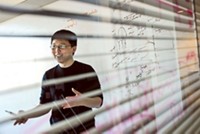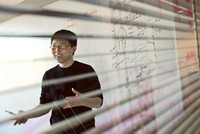Advertisement
Grab your lab coat. Let's get started
Welcome!
Welcome!
Create an account below to get 6 C&EN articles per month, receive newsletters and more - all free.
It seems this is your first time logging in online. Please enter the following information to continue.
As an ACS member you automatically get access to this site. All we need is few more details to create your reading experience.
Not you? Sign in with a different account.
Not you? Sign in with a different account.
ERROR 1
ERROR 1
ERROR 2
ERROR 2
ERROR 2
ERROR 2
ERROR 2
Password and Confirm password must match.
If you have an ACS member number, please enter it here so we can link this account to your membership. (optional)
ERROR 2
ACS values your privacy. By submitting your information, you are gaining access to C&EN and subscribing to our weekly newsletter. We use the information you provide to make your reading experience better, and we will never sell your data to third party members.
Biological Chemistry
CRISPR creators duke it out in U.S. patent court
Attorneys representing UC Berkeley and the Broad Institute argue over whose patent matters more
by Ryan Cross
December 7, 2016

In the biggest science showdown of the year, attorneys defending rival CRISPR/Cas9 gene editing patents faced off at the U.S. Patent & Trademark Office (USPTO) in Alexandria, Va., yesterday. The public hearing attracted a large turnout that spilled into two overflow rooms, with one attendee describing it as a “spectator sport” for patent lawyers and investors.
CRISPR technology is regularly hailed as the biggest biotech breakthrough since the DNA-amplifying PCR method was invented. The tool is sweeping through research labs, making gene editing cheaper and easier than ever. Billions of dollars are at stake in this patent dispute, experts say, given that CRISPR could be applied in agriculture, in medicine, and potentially in other lucrative areas. Companies including Novartis, DuPont, and Bayer are already lining up to acquire licenses from the party they hope will prevail.
The conflict began in April 2014 when the Broad Institute of MIT and Harvard University was awarded the first of several U.S. patents for CRISPR, even though researchers from the University of California, Berkeley, and the University of Vienna had filed their own patent applications first. In January 2015, USPTO announced an interference proceeding would pit the Berkeley and Vienna teams against Broad to determine the actual originator of CRISPR.
After months of anticipation and each side submitting hundreds of documents to USPTO, judges heard arguments from attorneys yesterday who were unwavering in their parties’ claims to CRISPR fame.
“Each side is vying for a winner-take-all scenario, which they may not get,” says Arti Rai, codirector of the Duke Law Center for Innovation Policy. Prior to yesterday’s hearing, Rai had anticipated little argument about who did what and when. And she was right. The judges instead probed the attorneys on interpretations of and motivations behind rather technical scientific accomplishments.

During a patent interference, the invention in dispute is given a formal description by USPTO. The patent office explicitly described CRISPR as a method used in eukaryotic cells, such as yeast or human cells. Broad’s attorneys argued that the interference shouldn’t even be taking place because Feng Zhang and coworkers at Broad were the first to publish a demonstration of CRISPR in eukaryotic cells (Science 2013, DOI: 10.1126/science.1231143), which is what Broad holds patents on.
In response, attorneys for UC Berkeley argued that the patent office was wrong to specify that CRISPR is intended for use in eukaryotic cells. Jennifer Doudna of UC Berkeley and Emmanuelle Charpentier, formerly of the University of Vienna, and their coworkers published the paper widely recognized as what led to the birth of CRISPR/Cas9 gene editing (Science 2012, DOI: 10.1126/science.1225829). Their patent, filed ahead of Broad’s, describes the use of CRISPR in prokaryotes, such as bacteria. The Berkeley-Vienna team argued that although the original patent described prokaryotic work, the technology was always intended for use in eukaryotes too, an obvious next step.
Speaking for Broad, attorney Steven R. Trybus asserted that the use of CRISPR in eukaryotes—making medical and agricultural applications possible—represents a significant advance worthy of a patent separate from UC Berkeley’s. Trybus pulled up a timeline showing several other research groups that were vying for first place in the race to use CRISPR in lab-cultured human cells. “These groups did not think they were doing an obvious extension” of UC Berkeley’s work, he contended.
Berkeley disagreed. In his rebuttal, attorney Todd R. Walters said moving CRISPR from prokaryotes to eukaryotes was inevitable. “There was no special sauce here,” Walters said after emphasizing Broad’s use of “conventional techniques” to get CRISPR into eukaryotic cells.
Broad in turn used Doudna’s own words as evidence against UC Berkeley, citing instances in which Doudna told the press she expected “many frustrations” in moving from prokaryotes to eukaryotes. The attorneys also pointed to a passage in Doudna’s first paper using CRISPR in human cells where she writes: “It was not known whether such a bacterial system would function in eukaryotic cells” (eLife 2012, DOI: 10.7554/eLife.00471.001).
At the hearing, the prokaryote/eukaryote debate was further complicated by UC Berkeley’s attorneys emphasizing a neglected contribution to CRISPR technology introduced in Doudna’s original 2012 paper. Her team was the first to covalently combine two separate RNA molecules to form what is called a single guide RNA (sgRNA) and is now widely used in the gene editing field. This molecule directs the Cas9 enzyme—important for the actual editing—to a DNA location specified by the scientist, one feature making CRISPR useful and user-friendly.
Doudna’s sgRNA is a synthesis of two bacterial molecules. One, called tracrRNA, is an unchanging scaffold that binds to the Cas9 enzyme, while the other, called crRNA, contains a variable sequence of 20 nucleotides that helps the complex target a particular gene. Using sgRNA is a standard approach among CRISPR scientists now. But Zhang’s original 2013 publication does not combine tracrRNA and crRNA into one RNA molecule.
“The one RNA molecule is a big deal because that doesn’t exist in nature. No one is going to dispute that,” says Cook-Deegan, a genomics intellectual property and policy expert from Arizona State University. In a debriefing after the USPTO hearing, Cook-Deegan said that the intricacies of the case could lead to an outcome where both sides are partial winners and partial losers. UC Berkeley may get awarded its patent but only for prokaryotes, and Broad may retain its narrower eukaryote patents but imposed with certain limitations.
“Neither party is likely to be happy if they are the loser,” says Gregory Graff, an economist at Colorado State University. “There is almost certain to be actual litigation in court regardless of what the patent office determines,” he adds, meaning that despite the outcome, the losing party may appeal the decision to a higher court. That would take the dispute out of the hands of the panel of patent office judges, which includes an individual with a Ph.D. in molecular biology, and into the hands of a judge who is unlikely to have any scientific background.
Jacob S. Sherkow from New York Law School has been following the case closely. At the debriefing after the hearing he said that although there is no required deadline by which the judges must make a decision, “it is my hope that we will see a big substantive decision probably in February.” But if either or both parties appeal the decision, CRISPR could linger in court for years.




Join the conversation
Contact the reporter
Submit a Letter to the Editor for publication
Engage with us on Twitter